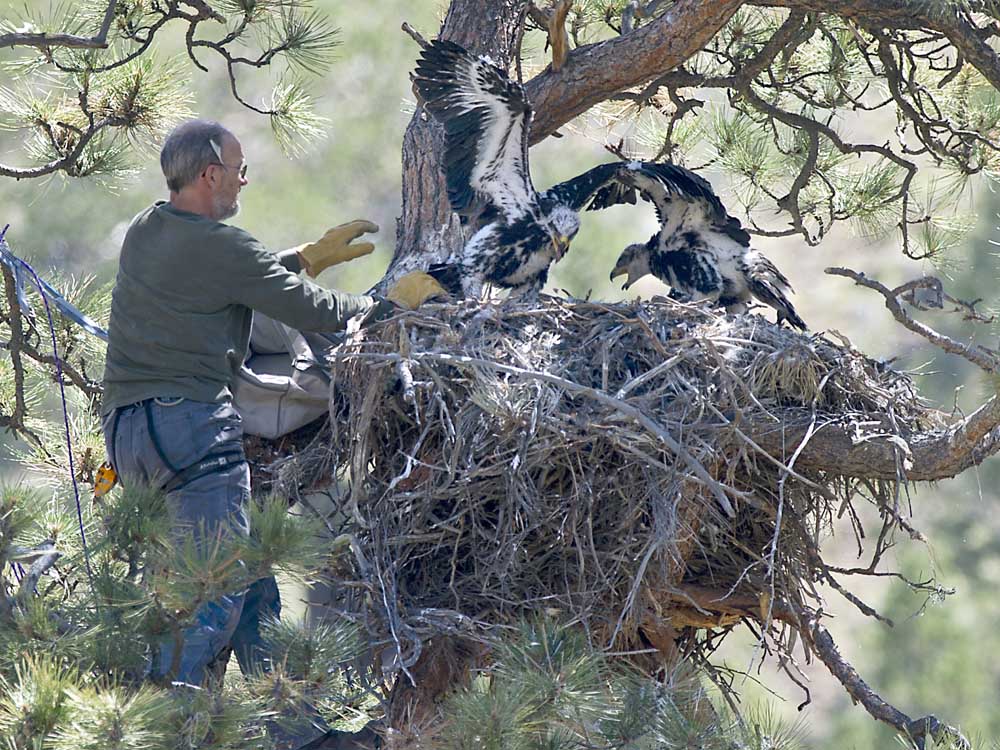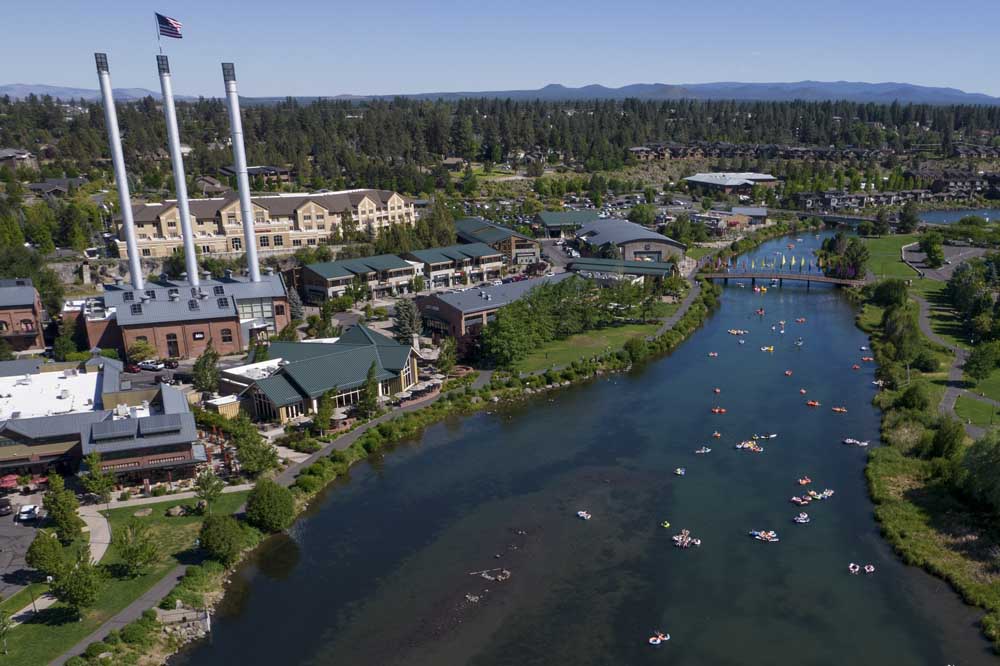Keeping tabs on Central Oregon’s golden eagles
Published 7:01 am Saturday, June 11, 2016

- Ryan Brennecke / The BulletinVolunteer Laingdon Schmitt works on removing a juvenile golden eagle from its nest while trying to band the pair of eagles east of Bend on Monday.
On Monday morning, parked off the side of a dirt road about an hour east of Bend, Jim and Sue Anderson and their 6-year-old grandson Truman use spotting scopes and binoculars to scan the skies above a tall pine tree in the distance, where they know a pair of golden eagles has nested with two baby eagles.
They’re hoping the eaglets have not yet left the nest, since they just about double in weight and size each week and can fledge in about two months.
They spot the mother eagle, flying above a nearby field.
“She’s lookin’ right at us,” says Jim, 88. “She’s sayin’: Oh, they’re back.”
“She just landed in the nest,” reports Sue, 67.
“That’s a good sign,” Jim declares. “That means the kids are still there.”
They load their folding beach chairs and bags with banding equipment and tools into a 1994 Toyota 4Runner — a metal ladder strapped along its roof — to drive over grassy, bumpy terrain. Their “climber,” Laingdon Schmitt, 51, a former sailboat rigger, follows on his motorcycle. Closer to the tree, the group leaves the vehicles, gathers the equipment and walks about a half-mile to the site, following a cow path between rocky hillsides and pausing to step over a small wire fence.
At the pine tree, Sue climbs an adjacent rocky slope to get a better view into the nest with a pair of binoculars. She sees the eaglets, with white feathers on their heads, so still young enough to put bands on.
“They’re about 6 weeks,” she calls down to Jim.
At the base of the nearly 100-foot-tall pine tree, Jim and Schmitt lean the ladder against the trunk so that it reaches the lower branches.
“This is the streamlined version,” Schmitt says of his planned ascent. “Ladder and backyard-style climbing, no ropes required.”
He climbs to the top of the ladder that Jim holds, then pulls himself into the branches and disappears up the tree.
On the ground, Jim and Truman inspect eagle pellets — identifying bones, fur, claw, skull and guessing that the parts once formed a ground squirrel. Truman lies on soft brown pine needles, drawing eagles and their nest in a notebook.
Shortly, Schmitt lowers one end of a rope down and Jim clips a gray duffel bag to it.
“Rope up!” he calls up the tree.
“OK,” Schmitt calls back.
Soon the duffel bag reappears, lowered slowly down from the treetop. Sue places it on the ground and opens it to carefully lift out a baby eagle.
“Let it relax a little, but gotta get those feet,” she says of the big talons while holding the bird in both hands out in front of her.
Truman reads the number imprinted on a small metal band and Jim records it in his notebook. Then Jim measures the bird’s legs to check its gender — they figure this is a male. They clamp a band on its leg using a riveting tool, with a little space so that it isn’t tight. But they don’t expect the eaglet, just about fully grown, to get much bigger.
Jim checks beneath the bird’s right wing for parasites that can suck blood and eat feathers. Then Sue returns the bird to the duffel bag and ties the end of the rope hanging from the top of the tree to the bag’s handles. Up it goes. The process is done within minutes.
In a little while, the bag appears again, lowered carefully between branches. Sue catches it and pulls out the second eagle.
“Oh, man, this one’s a monster,” says Jim.
The Andersons normally band the birds when they’re 3 to 5 weeks old, but these two are 6 weeks old and have grown about a foot tall, weighing 6 or 7 pounds, with wingspans of about 4 feet.
The couple repeat the quick measuring and banding process, then send the bird back up in the bag. At the top, Schmitt lifts the bird into the nest. Then he climbs down the tree.
“I love it up there,” Schmitt says on the ground, smiling as he changes his shirt. “I definitely gotta build me a treehouse.”
Nest by nest
The Andersons have a federal permit to band birds, including the eagles, protected under international, federal and state measures. They enter their data at the U.S. Geological Survey’s online database that collects banders’ information. The USGS keeps an electronic history of each band number. The data help track birds’ dispersal, migration, behavior, life span, social structure, survival rate, population and reproduction.
The Andersons have been monitoring and banding golden eagles throughout Central Oregon for decades, as volunteer work and while leading educational programs with the Oregon Museum of Science and Industry, among other efforts. Jim used to climb the trees himself, and the couple brought their six children with them on site visits over the years, sending them up trees to the nests of other birds, not eagles. Jim’s 1992 book, “Tales from a Northwest Naturalist,” shows a photo of his younger self in plaid shirt and blue jeans on the cover, perched right beside a large golden eagle on the branch of a pine tree — the two apparently captured midconversation with Jim smiling at the eagle who stares back at him, beak open, in what looks like a laugh. Other photos show their children, posing for pictures with owls like siblings.
“They were in backpacks when we started going,” Sue recalled. The couple now bring their grandchildren, including Truman, visiting from Minnesota. A Memorial Day Weekend gathering last month entailed 24 family members heading out to band hawks.
“They’re doing the climbing for us now,” Sue said.
But banding isn’t the only effort to research golden eagles in Oregon.
The Andersons also work for Oregon Eagle Foundation, a nonprofit that started in 1986 to ensure monitoring of bald eagles and protection of their nests and habitat in Oregon. The foundation’s work expanded to include monitoring the nests of peregrine falcons and, in 2011, of golden eagles. The Andersons and volunteers monitor about 150 breeding areas in Central Oregon.
The recent wind energy boom made the lack of information on golden eagles apparent, said longtime bald eagle and golden eagle researcher Frank Isaacs, the statewide coordinator at the foundation who also does a lot of fieldwork. So a 10-year survey aims “to learn as much as we can about the nest sites and the activities of golden eagles in this state,” Isaacs said.
That includes determining whether the population is increasing or decreasing. Isaacs estimates more than 700 pairs of adult golden eagles are now in the state, plus about 350 babies for a total of about 1,750 individual golden eagles in Oregon — good news to him.
Sue expects the results of the 10-year monitoring effort to garner substantive data on the bird’s population and to show any patterns, such as those related to climate change.
“We really don’t know the status of the golden eagle in Oregon,” she said. “Now we’re gettin’ there. … Bird by bird, nest by nest.”
A treasure hunt and a privilege
Like wolves, golden eagles were long seen as nuisance predators.
“For a long time, they were just shot to get rid of them,” Isaacs said. “Shot, poisoned, trapped.”
So their numbers declined, although not to the point of the bald eagles’ population drop that prompted its endangered species listing.
Golden eagles face threats such as electrocution from electrical facilities; a lack of food; getting shot by poachers; and getting hit by vehicles and wind turbines. But the threat that most scares the Andersons involves rodenticide — rodent-killing poison — and lead bullets used to kill ground squirrels and other small animals that eagles then eat and feed to their babies. Jim describes the poisoning effect on eagles as horrific, wrecking their muscular and nervous systems before killing them. Sue wants the poison and lead bullets banned.
Golden eagles live a long time and return to the same nests, sites that next generations use.
“They’re kind of bonded to the territory,” Isaacs said. “That place is very important to them, the place they know intimately.”
Isaacs pointed to one 1875 report of a golden eagle nest in what is now Burns, and noted that a pair nested within sight of that same location last year, raising two young.
But some pairs don’t produce young for years, while others produce young every year. The sometimes tedious monitoring work requires visiting known nesting sites a few times through the spring and summer and detailing nest locations, how the birds act, the number of any young.
“The return trips are really important to learn what’s happening from one year to the next,” Isaacs said. “Takes more than one visit or one year to figure out what’s happening with a nest.”
Isaacs and the Andersons thrive on gathering that information and figuring it out.
To Isaacs, finding the remote and spectacular nesting sites — overlooking open spaces from cliffs and large trees at the edges of forests — becomes a treasure hunt. And this type of unique study “probably won’t be done again, at least not in our lifetimes,” he said.
Sue loves the birds, the country, getting out in the sagebrush and the High Desert. Jim’s favorite part is holding the baby eagles.
“I see something new, I feel the energy of the birds every time, I get crapped on — I’m part of the bird’s life and that really is a privilege to be that close to them,” he said.
— Reporter: 541-617-7812,
hcorrigan@bendbulletin.com
“We really don’t know the status of the golden eagle in Oregon. Now we’re gettin’ there. … Bird by bird, nest by nest.” — Sue Anderson, on the monitoring effort to collect data on the golden eagle






